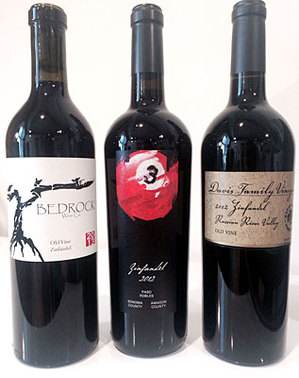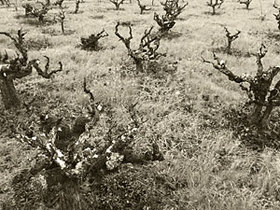| « Previous | News | Next » |
October 28, 2015
A True American Story
Written by Kate Soto
The Zinfandel story is an American story. The grape ended up on the East Coast via an Austrian nursery, and then made its way west with the gold rushers of the 1850s. This is the grape of westward expansion. This is the grape that thrived in the new land. This is an immigrant grape without the fancy French pedigree of Cabernet Sauvignon. DNA evidence connects it to Puglia’s Primitivo, but it was originally an obscure (and ancient) grape from Croatia called Crljenak Kaštelanski. This is the small-time grape that made it big.
The wine world loves a fad, and the Zinfandel grape has certainly seen its share of rides on the rollercoaster of popularity. Much of this is thanks to the now-maligned but once-chart-topping “white”—rather, pink—version of wine made from this grape; but overplanted, overripe versions of the red didn’t help matters. In fact, it wasn’t until I had a bottle of Carlisle Zinfandel—as recently as last year!—that I had my Eureka moment with the grape, so deeply imbedded was my own prejudice. And I think this might be true for many consumers, who lump the red in with the “white” as a drink for neophytes. But oh! What they’re missing.
Spicy, spunky, peppery, brambly—the grape is a great balancing act of savory and fruity notes. When planted in hot climates and allowed to overproduce, it can be jammy and uninteresting. But when it’s planted in the right cool climate and well-pruned, there’s a wildness to it; an air of mystery. It can be a structured, intense play between light and dark. The grape is thin-skinned but robust, so it can be medium weight and airy or rich and voluptuous. What you find in the glass really can surprise you.
Thankfully, even the White Zin phenomenon had its purpose: it served to ensure that Zinfandel vines were maintained by growers during a time when Americans were gulping up white wines and winemakers were pulling out red vines to make way. Today, the availability of old-vine Zin, along with thoughtful, respectful winemaking, has helped the grape see a resurgence in respectability. The Wine Institute notes: “Zinfandel is the third-leading wine grape variety in California, with more than 48,000 acres planted and 469,216 tons crushed in 2013, according to California Department of Food and Agriculture. It is grown in 45 of California’s 58 counties. Promoted to the world by the state’s vintners for more than 130 years, Zinfandel has grown beyond cult status and is now internationally recognized due to the unique character and high quality wines that are produced only in the Golden State.”
It’s a good time to release Zin from the sins of its past and try the new wave of wines made from this humble and hearty grape.
 3 Ball 2012 Zinfandel, California
3 Ball 2012 Zinfandel, California
Surfer, punk rocker, former chef, and all-around wine bad ass Christian Tietje came to Zinfandel almost by default. He set out to make Pinot Noir, but couldn’t really afford to produce it. He gravitated toward Zinfandel, which, in his mind, was misunderstood (and which would seem to jive perfectly with the personality of someone whose motto is: “If we’re not pissing off 10 percent of the population, we’re not doing our job.”) 3 Ball is an ode to his three favorite appellations, culling the characteristics from each: sophisticated Sonoma, wild Paso, and rustic Amador, blended to create a killer bottle of red for a reasonable price. In the glass, it’s a pretty plum color with good light transparency. You get an immediate sense of red bramble fruit, which then moves to cranberry, tar, and something akin to tarragon or sage. It’s medium-bodied but spreads out on the palate, where it entertains sweet-savory yin yang, like salted caramel, beef broth, and licorice. This wine is broad and generous, with a unique, delicious funkiness to it.
Bedrock 2013 Old Vine Zinfandel, California
Morgan Twain-Peterson was raised at his father’s Ravenswood winery and grew up immersed in the world of wine. Legend has it he was a wine wunderkind; according to David Darlington’s book Angel’s Visits, that “Morgan, at the age of five, could distinguish between Merlot and Zinfandel.” He founded Bedrock in a 550-square-foot former chicken coop with the motto: “To dream big but keep production low!” He takes minimal winemaking to heart—“By bare minimum I mean handling fruit gently, in many cases using whole-clusters, and fermenting exclusively with the microflora that comes in with the grapes or is already present in the winery. I use a little new, excellent, French oak and rack as infrequently as possible. I strongly feel that picking the moment the flavors are there is the best way to express site. Thus, I tend to pick earlier than most.”
His Zin comes from vines that average 80+ years. With Carignane, Mourvedre, Grenache, Petite Sirah, Abouriou, and Aubun in the mix, it’s a proper field blend. It’s a dark purple with a lively pink rim. Aromas of pepper and a touch of funk start it off, then notes of bright, fresh-picked grapes and soft violet pastille. A complex dark cherry, kirsch, and black tea open up on the palate, then it ends on a firm, dry finish. This is a seductive wine—not va va va voom, but sexy librarian.
Davis Family 2013 Old Vine Zinfandel, Soul Patch Vineyard, Russian River Valley
Guy Davis studied to be a stockbroker, but decided he didn’t want to talk about money all day. After years in the restaurant biz, he turned his economics degree toward the wine industry. His first vineyard experience was with organically farmed Old Vine Zin at Sky Vineyard, and he got hooked. He and his wife opened their own venture in the 80s, and since then it has been truly a family project with sons Cole and Cooper, and young grandson Luke all in the mix. They are passionate about wine being an integral part of meals, of friendships, and of life. They grow gorgeous Pinots, Cabs, Rieslings, and Chardonnays as well, but there’s something truly special about their Zin. With vines planted in 1896—that’s 119 years, folks!—the depth of flavor and texture they achieve is astounding. In fact, I’d decant their 2013 before drinking, as it takes a bit of air to truly mine the depths. The medium-bodied wine is deep brick mahogany magenta, with a pretty nose of raspberries, plums, violet, bramble fruit, and pepper. With air, the red raspberry fruit shines, underlined by light floral notes. Palate shows licorice, currant, light caramel, and spice but becomes more red fruited with air, while maintaining licorice and tobacco leaf. It’s complex and very pretty, ending on a subtle vanilla bean note.
Alex Cooper Project 2011 Red, Doug Rafanelli Vineyard, Dry Creek Valley
Rodney Alex spent 20 years in the restaurant biz in Chicago; Rick Cooper spent 40 years in the music biz promoting records. With the help of good friend Guy Davis (see above), they were introduced to legendary vineyard owner Doug Rafanelli. Thus began their foray into making wine: with good friendships and killer grapes. These lucky grapes are hand harvested, gently destemmed, and then treated to a loop of John Coltrane’s A Love Supreme on loud speakers aimed directly into the tank while they are fermenting. Their Zin, which contains 5 percent Petite Sirah, is concentrated, deep, and dark as a late-night jazz club. Beginning with white pepper, plum, and tobacco leaves, it moves toward stewed blackberry jam with notes of lavender and sage and mocha, all in a high-acid, electric package. As the winery put it (and I can’t put it any better): “The mouthfeel is as silky as Lou Rawls on a first date.”
 Valravn 2014 Old Vine Zinfandel, Sonoma County
Valravn 2014 Old Vine Zinfandel, Sonoma County
This is a new Sonoma County Zinfandel from our friends at Banshee. Baron Ziegler explains their inspiration, “When we moved to Healdsburg in 2013, I couldn’t believe how many backyard vineyards of old, bush pruned, Zinfandel vines there were canvasing the Dry Creek Valley. These vines are as old and impressive as anything I’ve ever seen in Europe, and immediately we set out on a scavenger hunt to try and find an old heritage clone vineyard of old vines that we could work with. We wanted to take advantage of this amazing raw material and see what we could do with it. In 2014 we were able to contract two vineyards that ranged in age from 50 to 105 years old. These are non-irrigated, dry farmed, own rooted Zin vines that yield around 3 tons/acre. These are the real deal…” This wine is new to Cream. Layers of richness and complexity are wrapped around a core of wild strawberry, raspberry, blackberry compote and hints of licorice-laced black pepper.
